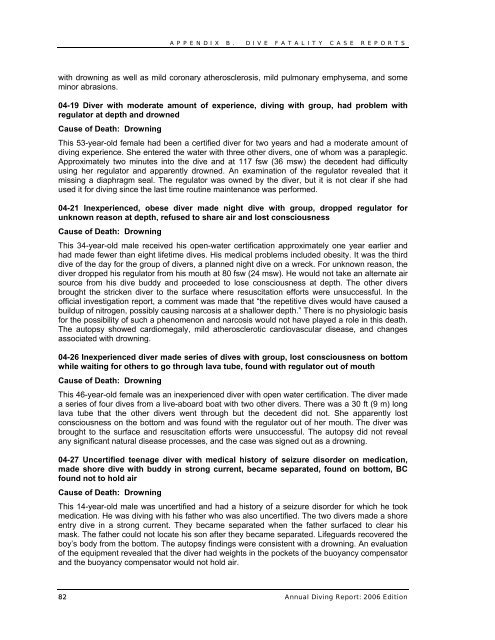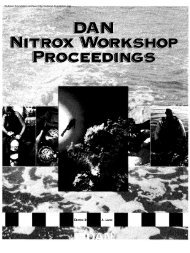Annual Diving Report - Divers Alert Network
Annual Diving Report - Divers Alert Network
Annual Diving Report - Divers Alert Network
Create successful ePaper yourself
Turn your PDF publications into a flip-book with our unique Google optimized e-Paper software.
APPENDIX B. DIVE FATALITY CASE REPORTS<br />
with drowning as well as mild coronary atherosclerosis, mild pulmonary emphysema, and some<br />
minor abrasions.<br />
04-19 Diver with moderate amount of experience, diving with group, had problem with<br />
regulator at depth and drowned<br />
Cause of Death: Drowning<br />
This 53-year-old female had been a certified diver for two years and had a moderate amount of<br />
diving experience. She entered the water with three other divers, one of whom was a paraplegic.<br />
Approximately two minutes into the dive and at 117 fsw (36 msw) the decedent had difficulty<br />
using her regulator and apparently drowned. An examination of the regulator revealed that it<br />
missing a diaphragm seal. The regulator was owned by the diver, but it is not clear if she had<br />
used it for diving since the last time routine maintenance was performed.<br />
04-21 Inexperienced, obese diver made night dive with group, dropped regulator for<br />
unknown reason at depth, refused to share air and lost consciousness<br />
Cause of Death: Drowning<br />
This 34-year-old male received his open-water certification approximately one year earlier and<br />
had made fewer than eight lifetime dives. His medical problems included obesity. It was the third<br />
dive of the day for the group of divers, a planned night dive on a wreck. For unknown reason, the<br />
diver dropped his regulator from his mouth at 80 fsw (24 msw). He would not take an alternate air<br />
source from his dive buddy and proceeded to lose consciousness at depth. The other divers<br />
brought the stricken diver to the surface where resuscitation efforts were unsuccessful. In the<br />
official investigation report, a comment was made that “the repetitive dives would have caused a<br />
buildup of nitrogen, possibly causing narcosis at a shallower depth.” There is no physiologic basis<br />
for the possibility of such a phenomenon and narcosis would not have played a role in this death.<br />
The autopsy showed cardiomegaly, mild atherosclerotic cardiovascular disease, and changes<br />
associated with drowning.<br />
04-26 Inexperienced diver made series of dives with group, lost consciousness on bottom<br />
while waiting for others to go through lava tube, found with regulator out of mouth<br />
Cause of Death: Drowning<br />
This 46-year-old female was an inexperienced diver with open water certification. The diver made<br />
a series of four dives from a live-aboard boat with two other divers. There was a 30 ft (9 m) long<br />
lava tube that the other divers went through but the decedent did not. She apparently lost<br />
consciousness on the bottom and was found with the regulator out of her mouth. The diver was<br />
brought to the surface and resuscitation efforts were unsuccessful. The autopsy did not reveal<br />
any significant natural disease processes, and the case was signed out as a drowning.<br />
04-27 Uncertified teenage diver with medical history of seizure disorder on medication,<br />
made shore dive with buddy in strong current, became separated, found on bottom, BC<br />
found not to hold air<br />
Cause of Death: Drowning<br />
This 14-year-old male was uncertified and had a history of a seizure disorder for which he took<br />
medication. He was diving with his father who was also uncertified. The two divers made a shore<br />
entry dive in a strong current. They became separated when the father surfaced to clear his<br />
mask. The father could not locate his son after they became separated. Lifeguards recovered the<br />
boy’s body from the bottom. The autopsy findings were consistent with a drowning. An evaluation<br />
of the equipment revealed that the diver had weights in the pockets of the buoyancy compensator<br />
and the buoyancy compensator would not hold air.<br />
82 <strong>Annual</strong> <strong>Diving</strong> <strong>Report</strong>: 2006 Edition

















